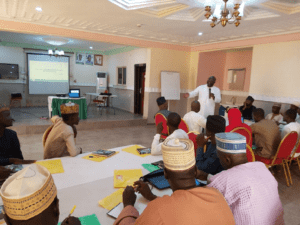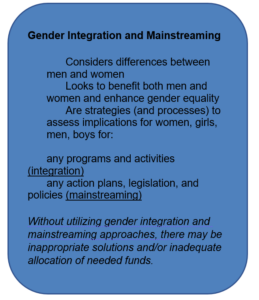Accounting for Gender and Social Inclusion Through Work Plan Development: My Experience With the Primary Health Care (2020-2021) Work and Business Plan
By Stella Abah, Gender, Social Inclusion, & Community Engagement Advisor, IHP Kebbi State, Nigeria

“Gender integration” and “mainstreaming” are phrases that we frequently use, but I often hear from colleagues, ‘what does that really mean,’ and ‘what does that look like in practice’? Though the terms may sound similar they are in fact not interchangeable. Gender integration is the process of assessing the implications for women, girls, men, boys for any programs and activities, whereas gender mainstreaming is the process of assessing the implications for women, girls, men, boys for any action plans, legislation, and policies. We know that integrating gender and social inclusion into all stages of activity planning, design, implementation, and monitoring and evaluation is critical to achieving the goals of the Reproductive, Maternal, Newborn, Child Health, Malaria, and Nutrition (RMNCH+NM) program that we support in Kebbi State in Northern Nigeria, through the USAID Integrated Health Program (IHP). Sometimes, however, even we gender advisors can get stumped when asked to identify tangible examples of gender and social integration. I saw this gap as an opportunity to showcase some of my recent experiences to demonstrate how natural and beneficial this process can be to men, women, boys, girls and society at large.
IHP is supporting Kebbi State in its efforts to strengthen health systems and revitalize primary health care (PHC) by providing technical assistance to employ an integrated model to increase the availability and accessibility of high-quality health services in every local ward. To maximize our effectiveness, and ensure that all partners work well together, IHP convened key actors from the State government and the health services delivery to define our goals, articulate our concerns, and design our activities for the coming year. At this year’s work planning workshop held in March 2020, we aimed to ensure that cross-cutting issues, such as gender and social inclusion, were more completely and consistently incorporated into all activities from the initial collaborative planning. To this end, IHP partnered with the Kebbi State Primary Health Care Development Agency to deliver a participatory workshop for 122 primary health care centers (1 per Ward) to develop an Integrated PHC 2020 Work Plan. 266 PHC and local government staff – PHC Directors, Deputy Directors, In-charges, and other facility staff – participated in the event.
As part of these collaborative efforts, I facilitated conversations to address gender inequality gaps and to promote a more gender-responsive plan; one where services can meet people from all walks of life including girls, women, boys, men, the young, the old, persons of various social and economic backgrounds, persons with disabilities, and other individuals. By integrating gender from the beginning into all aspects of government planning, we can make health services more effective and responsive to the diverse needs of each client, and by doing so improve health outcomes for the entire population. By working together, we helped foster buy-in and develop a document that is more likely to be implemented and taken forward rather than collect dust on a desk.
Our methodology for integrating gender and social inclusion considerations and mainstreaming gender into the work plan was to thoroughly examine the following areas to identify opportunities for workplan enhancement:
- Policies
- Guidelines and Protocols
- Budgeting
- Workforce management
- Facility management
- Respectful, people-centered care
- Reporting
Gender Mainstreaming – What We Accomplished

In examining the Plan’s existing elements and creating new ones, we brainstormed specific gender and social inclusion activities and then worked together to prioritize the most important and feasible. Among group members we decided to focus on :
- Building the capacity of service providers to deliver gender-responsive health care services through group and on-the-job training.
- Ensuring the privacy of clients and respecting confidentiality (this includes both visual privacy and auditory privacy) while providing services, especially for women and girls.
- Look for opportunities to provide formal training and build the capacity of male and female staff designated to provide adolescent and youth-friendly health services with the same considerations for privacy and confidentiality as adults.
- Creating adolescent and youth-friendly spaces (like a designated room, demarcation or divider screen, convenient time of day) to deliver the specified health services.
- Identify separate, functional, and safe toilets in PHCs for males and females.
- Make referral processes more gender-responsive by looking at the unique needs of each client.
At the end of the planning workshop, the participants pledged to drive the process and implement activities captured in the work plan, creating a culture of shared responsibility and accountability. In my opinion, engaging these stakeholders and their staff in this type of active development of their own PHC work plan with defined and clear structured roles and responsibilities is one of the key ways we can strengthen health systems and support service improvements in a way that is sustainable and responsive to the to the needs of women, men, girls, and boys across Kebbi State. IHP will continue to provide technical assistance – including additional gender integration and mainstreaming support – to Kebbi State as it works to address its priority health goals and objectives and ensure no one is left behind. I am so happy to be a part of this effort!